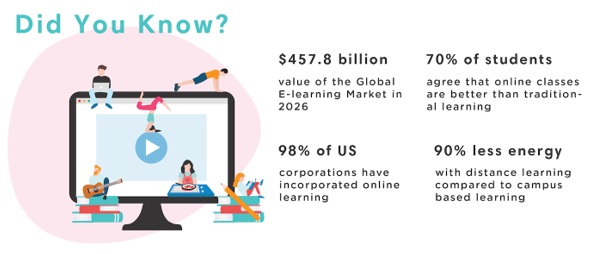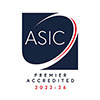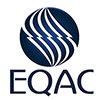Personalized Learning In The Digital Age: Aligning The Classroom With Student Goals
12th February 2024

We live in a digital age where technology has transformed almost every aspect of our lives. From communication to entertainment, every individual from children to adults is surrounded by screens and devices that seem to have all the answers and solutions at their fingertips.
But what about education? Can we harness the power of technology to create a truly personalized learning experience for students?
Well, the answer is yes, and we have witnessed it during the tough COVID times when there was no other option other than the online way of learning when the whole world was in lockdown. Because of this e-learning trend, it is predicted that by 2026, the value of the global e-learning market will reach $457.8 Billion.

Source: upskillwise.com
Then, read our blog post and get ready to dive into a new era of education where classrooms transform into dynamic spaces tailored specifically for each student's unique needs and aspirations with easy-to-implement strategies.
Before moving to the topic, can we ask you a question? Do you follow us on Social Media? We regularly share upgraded educational content, tips, feedback, and more. Check us out by clicking the profiles here - Facebook / Twitter / LinkedIn / Pinterest / Instagram / YouTube
So, without any further delay, let’s get started.
1. Figure Out Your Vision of Learning Goals
When you’re finding and evaluating ed tech tools for specific learning goals or activities, it is important to establish your students' learning objectives and methods of assessing their progress. It is recommended to have SMART (Specific, Measurable, Achievable, Relevant, and Time-bound) goals in place that align with curriculum standards, student needs and interests, and the overall learning outcomes for the course or unit. Be sure to communicate these goals with your students so they are aware of their expectations and the purpose behind them.
2. Finding The Right Ed Tech Tools & Resources
After establishing your learning goals, you can search for ed tech resources to supplement them. Although there is a wide range of options, not every tool aligns with your goals, teaching approach, or students' preferences. To make the best choice, take into account the tool's instructional benefits and limitations, technical specifications, accessibility features, pricing, and privacy concerns.
Additionally, consider how the tool can be integrated into your lesson plan, classroom management style, and evaluation methods. You must focus on finding and evaluating quality educational apps and resources that enhance your instructional practice in the classroom rather than substitute them.
3. Create Engaging Activities for Your Digital Classroom
Once the ed tech tools have been chosen, the next step is to create engaging activities that will assist your students in reaching their learning objectives. These activities should align with the instructional strategies, assessment criteria, and learning goals. Additionally, they should prioritize student involvement, interaction, collaboration, and purposefulness.
To aid in designing your ed tech activities, you can utilize frameworks like SAMR (Substitution, Augmentation, Modification, and Redefinition), TPACK Technological Pedagogical Content Knowledge), or UDL Universal Design for Learning).
Furthermore, seeking inspiration from other ed tech teachers through online resources such as blogs, podcasts, or webinars can also be beneficial.
4. It’s Time To Teach
Once you are ready to put your ed tech teaching into practice, it's important to be fully prepared. This means testing all ed tech tools and activities in advance, ensuring they function smoothly. Also make sure to provide clear instructions and expectations to your students, as well as offering feedback and support to make their learning fun and engaging.
To ensure a positive and safe learning environment, set guidelines for responsible and respectful use of ed tech tools. Additionally, you also need to be sure to measuring the impact of ed tech on student learning outcomes and adjust as needed in your instruction.
5. Evaluate Your Teaching
Once your ed tech teaching has been put into practice, it is important to assess its effectiveness and how it has impacted your learning objectives. This involves gathering and examining data from multiple sources, including student work, quizzes, surveys, observations, and reflections. By comparing this data with your learning goals, you can identify areas of strength and weakness in your ed tech teaching.
Additionally, seeking feedback from your students about their learning experiences, difficulties encountered, and suggestions for improvement can also be helpful. Utilizing this data and feedback will allow you to make improvements to your ed tech teaching and acknowledge any successful outcomes.
Aligning The Classroom With Student's Goal Has Now Become Easier
There’s no denying that EdTech is the future of the education industry and it’s becoming one of the first choices for children to consume their learning. However, aligning digital learning objectives with student’s learning needs and goals is quite challenging.
However, this blog post contains all the required strategies you need to fostering student agency and self-directed learning through personalized ed tech way of learning.
So, whether you’re a school leader or educator, it’s best to pursue courses like Online Educational Administration & Management courses which will make you realize that technology can serve as a powerful tool to enhance learning and prepare students for the future.
We believe education should be accessible for everyone. That’s why we don’t charge for our blogs. Find the right course that will help you in your career with us, contact us at - 1800–212–6400. You can mail us at act@asiancollegeofteachers.com.












